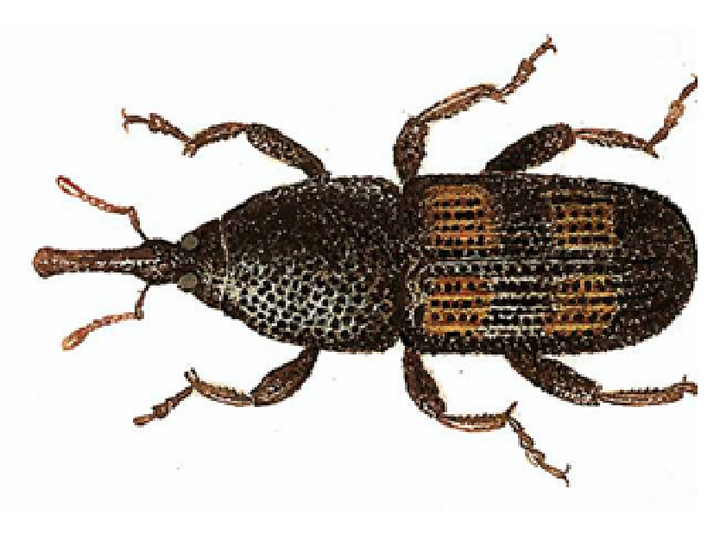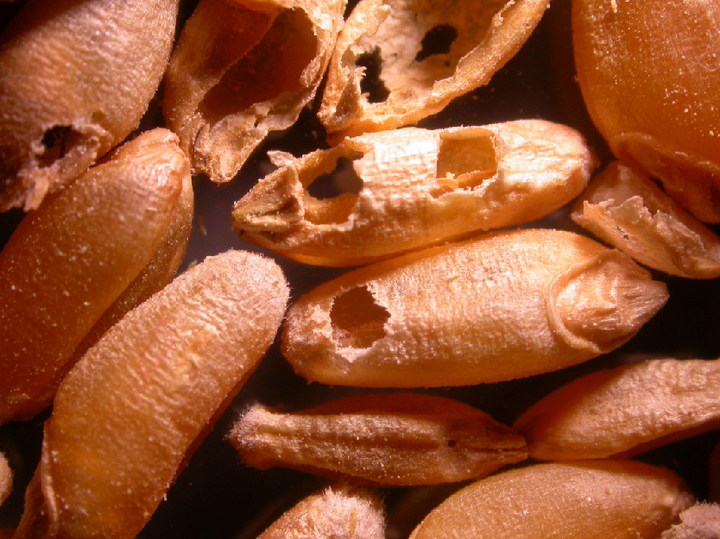Rice weevil
Sitophilus oryzae
Appearance

The rice beetle is characterized by its proboscis-like elongated head. The beetles, which are about 2.5 to 3.5 mm reddish brown, are easily recognizable by four indistinct yellow-brown spots on the elytra and the coarsely dotted neck shield.
The larvae are legless, whitish in color and have a light brown head capsule.
Biology
The rice weevil belongs to the weevil family (Curculionidae). It is closely related to the grain weevil and very similar to it in appearance and lifestyle. Unlike the grain weevil, the rice weevil is capable of flight. The females can lay up to 300 whitish shiny eggs and gnaw a hole in a grain kernel, lay an egg inside and close the cavity with a secretion drop. The hatching beetle larvae spend their entire life in the cereal grain. They pass through four larval stages and finally pupate in the grain. Development from oviposition to the finished insect takes 90 days at 18°C, 33 days at 26°C, and no growth takes place above 34°C. The optimum temperature for the beetles is 18°C. The optimum temperature is 30 °C.
The life span of adult beetles is three to four months at normal Central European temperatures. The survival of the beetles without food is strongly dependent on the ambient temperature and is one to two weeks at room temperature, and correspondingly longer at cold temperatures. All developmental stages are able to survive temperatures around freezing for about a week, so overwintering in unheated storage rooms at low temperatures is usually possible.
Damage symptoms

Hollowed out cereal grains are characteristic of an infestation with the rice weevil. In the case of high infestation density, weight losses of the grain are recorded. In severe infestation, the feeding activity and the associated metabolic processes lead to an increase in the temperature of the stored goods. Fungi and bacteria also colonize the grain. The stored goods agglutinate, become inedible and take on a musty to manure-like odor. As a result of condensation, the stored grain begins to grow out on the surface.
Prevention and control
General hygiene measures
- Periodic and thorough cleaning of storage facilities
- Pest monitoring
- Temperature measurement in the stored goods
- Cooling (10-13 °C) and drying of the stored goods
- Disposal of junk and cleaning waste
- Destruction of already infested supplies
- mechanical prevention of beetles by sealing windows and doors (insect screens)
- Insulation of ceilings, walls and pipes (prevention of condensation)
- Plastering of crevices, cracks and porous walls
- Thorough cleaning of harvesting and transport machinery and storage rooms before storing the harvest
- Empty space treatment with a plant protection product (see list of plant protection products approved in Austria) or heat treatment
Proof
- Periodic temperature measurement: a rise in temperature in the stored goods provides information about the presence of storage pests
- Sampling with a grain sampler
- Sieving of samples with a continuous sieve
- Float test: infested, hollowed-out cereal grains float on the surface of the water and can be examined for rice beetle larvae
- Noise measurement: detection of larval feeding sounds by inserting a sensitive microphone into stored supplies
Control
- Control of the rice weevil and its larval stages requires increased effort due to protected larval development inside the grain kernel.
- Inert dusts (diatomaceous earth) and contact insecticides allow successful control of adult beetles when distributed appropriately in stored grain. However, larvae and eggs deposited in the grain are not captured and can continue to develop unhindered inside the grain.
- Safe killing of all stages is achieved with gaseous agents (hydrogen phosphide, see list of plant protection products approved in Austria) including inert gases (nitrogen, carbon dioxide).
- Thermal treatments (60 °C for three minutes) or cold treatments (below -10 °C) are possible, but only effective for smaller batches due to the energy required.
- Biological control by release of the pea wasp Lariophagus distinguendus (see list of plant protection products approved in Austria). This insect finds the rice weevil larvae and pupae living hidden in the grain thanks to its good sense of smell.
Tips for household use
- Store food only in well-sealing storage containers with rubber seals or screw caps
- Dispose of all infested food directly in the garbage can outside the house
- Remove bugs sitting around with a vacuum cleaner
- Fly screens on (roof) windows, doors and skylights reduce the risk of infestation
- If you are repeatedly struggling with rice beetles, wasps can help. These are natural enemies of the beetles and are simply released in the kitchen(Lariophagus distinguendus, see list of plant protection products approved in Austria).
Last updated: 06.09.2024
automatically translated